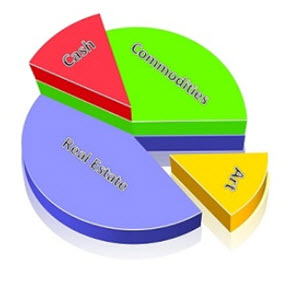For professional successful investors and speculators, diversification is second nature. Sure, they may talk a lot about how great a certain money-making scheme is right now, but if you were to look closer into their personal assets you would find that they are diversifying and hedging like a boss.
 Ordinary small-scale investors, on the other hand, are notoriously bad at diversifying. For many, their diversification plan looks something like this:
Ordinary small-scale investors, on the other hand, are notoriously bad at diversifying. For many, their diversification plan looks something like this:
- Invest almost everything in my home (an asset that I can’t sell without becoming homeless).
- Put a small amount of money into a retirement savings fund each month and keep my fingers crossed that exorbitant management fees won’t eat up most of the profits before I retire.
- Buy stocks in that awesome company that I hear so much about in the news.
This really isn’t a very good strategy.
When it comes to investment diversification, we should strive to not be dominated by exposure to a particular asset, or asset class or risk. A properly diversified portfolio will have less variance than the weighted average variance of its constituents. A portfolio with a volatility that is smaller than the volatility of its least volatile constituents is also desirable.
A few examples of what you can do to increase diversification:
- Invest in different asset types, e.g. income property, bonds, shares, funds, etc.
- Make sure your investments vary in risk. If you already have invested in blue chip stock (an investment considered fairly low risk) you could diversify by also investing in something that’s deemed a bit riskier. The key here is more risky, which isn’t the same as high-risk. You don’t have to invest in asteroid mining to increase diversification, you just need to find something a bit more risky than the blue-chip stocks.
- Some investments tend to do well when the overall economy is doing well, but do poorly in a recession. Increase your diversification by mixing such investments with investments that are likely to plow through a recession relatively unscathed and investments that are actually likely to do better in a recession than in a booming economy (e.g. fast food company shares).
- Even if you have a favorite industry, don’t put all your eggs in that basket.
- If you invest in stocks, try to find suitable stock companies of varying size and age. Don’t just go for well-established companies, or only start-ups, or only Fortune 500 companies, etc.
- Geographical diversification is important. We are often told that we live in a global economy today, but that doesn’t mean that geographical diversification has become obsolete.
- There are investment opportunities available that won’t be offered by your stockbroker or be found in the glossy mutual funds catalog you receive from the bank. It’s your money and you are allowed to color outside the lines if you want to. Maybe you want to bury gold doubloons in your garden. Maybe you want to give seed capital to that super small-scale venture that is based in your own neighborhood. Maybe that Hermès Birkin Bag will more than double its market value in 5 years.
Tip! The two main techniques for investment risk reduction are diversification and hedging.
This article was last updated on: November 21, 2018
